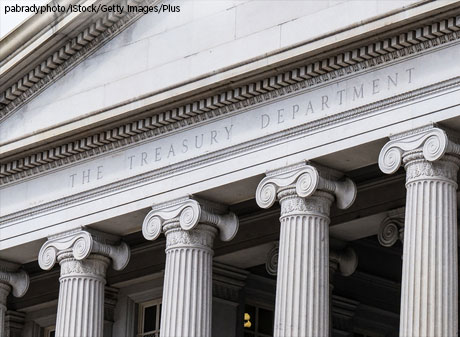Servicing the National Debt

This is the first post in a two-part series about the national debt.
Most people consider the national debt in the same way they would the debt of a household, in which high levels of debt and deficit spending are not sustainable and must be paid back or renegotiated at some point.
But are these two items similar? At the national level, U.S. federal debt reached $20.5 trillion (or 105% of gross domestic product) by the second quarter of 2020. What does increasing debt mean to the U.S., whose income has only grown by 30% in the past 12 years, while the debt has ballooned by 400% in the same period?
Senior Vice President and Economist David Andolfatto examined this issue in a recent Regional Economist article titled “Does the National Debt Matter?” To begin to answer that question, Andolfatto first looked at the topic from the perspective of debt issuance, debt as currency and debt service.
Debt Issuance
While household debt must eventually be repaid, a government can, in principle, roll over its debt indefinitely, Andolfatto wrote. How is that possible? The short answer lies in U.S. Treasury bonds— marketable securities that are used in financial markets as a form of money.
For example, corporations that need cash to meet obligations can sell Treasury securities or use them as collateral in a short-term sale and repurchase agreement, he pointed out. Treasury securities also trade at a premium relative to other securities because investors value their liquidity and safety.
Ultimately, the federal government controls the nation’s legal tender, and Treasuries have been considered legal tender since 1933. The national debt consists of Treasury securities payable in legal tender. When the interest comes due, the government can pay in legal tender, i.e., printing more money. This means default can only occur if the government allows it, Andolfatto noted.
“The situation here is similar to that of a corporation financing itself with debt convertible to equity at the issuer’s discretion,” he wrote. “Involuntary default is essentially impossible.”
Debt as Currency
The amount of the national debt held domestically can be viewed as private sector wealth. The implication is that increasing the national debt makes individuals feel wealthier, the author noted.
We may want to look at the national debt from a different perspective, Andolfatto observed.
“In particular, it seems more accurate to view the national debt less as form of debt and more as a form of money in circulation,” he wrote. “Investors value the securities making up the national debt in the same way individuals value money—as a medium of exchange and a safe store of wealth.”
Not having to worry about paying back the national debt doesn’t mean there is nothing to be concerned about, the author noted. But if the national debt is a form of money, what is the concern?
Debt Service
Treasury securities bear interest or sell at a discount, so even if the national debt doesn’t have to be paid back, it still needs to be serviced, Andolfatto wrote. The interest expense associated with carrying debt is its carrying cost. What kind of corporate debt management principles could apply to the government? An example might be a bank. A significant amount of debt issued by banks is in the form of insured deposit liabilities, which are safe and constitute money.
Because of that, investors are willing to carry deposits at low yields, making them a cheap form of funding for banks, he observed.
Banks use these low-cost funds to carry higher-return assets such as mortgages, so, in this case, one could say that the net carry cost of debt is negative, the author noted.
“To the extent that the federal government invests in programs designed to enhance productivity (e.g., healthcare and infrastructure), the same thing might apply to the national debt, which is willingly carried by investors at relatively low yields,” he wrote.
But even if its spending does not generate high pecuniary rates of return, the federal government may still be able to carry its debt at an effective negative rate, Andolfatto observed.
“This would be true, for example, if the interest rate on the national debt was on average less than the growth rate of the economy,” he wrote.
The next post examines the concepts of monetizing the national debt, inflation and how the COVID-19 pandemic has affected the bigger debt picture. See: Does Rising National Debt Portend Rising Inflation?
Additional Resources
- Page One Economics: Making Sense of the National Debt
- FRASER: Who Holds the National Debt?
This blog offers commentary, analysis and data from our economists and experts. Views expressed are not necessarily those of the St. Louis Fed or Federal Reserve System.
Email Us
All other blog-related questions

